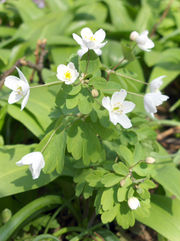Isopyrum
| Isopyrum subsp. var. | ||||||||||||||||||||||||||||||||||||||||||||||||||||||||
|---|---|---|---|---|---|---|---|---|---|---|---|---|---|---|---|---|---|---|---|---|---|---|---|---|---|---|---|---|---|---|---|---|---|---|---|---|---|---|---|---|---|---|---|---|---|---|---|---|---|---|---|---|---|---|---|---|

|
|
| ||||||||||||||||||||||||||||||||||||||||||||||||||||||
| ||||||||||||||||||||||||||||||||||||||||||||||||||||||||
Isopyrum is a genus of flowering plants of the family Ranunculaceae native to Eurasia. It is sometimes treated as part of the North American genus Enemion.
| Standard Cyclopedia of Horticulture |
|---|
|
Isopyrum (from the Greek for like, and wheat, as the seeds resemble those of wheat). Ranunculaceae. Dwarf stemless herbs sometimes used in the wild garden. Annual, or rootstock perennial: lvs. decompound, ternate; lfts. 3-lobed or cut, membranous: fls. white, regular, few or solitary, on slender scapes; sepals 5-6, deciduous; petals 5, very small or wanting: carpels 2-20, sessile; ovules 3 or more. Fifteen to 20 species in temperate regions of the northern hemisphere. I. thalictroldes, Linn., is cult, in alpine gardens, and has graceful foliage resembling a maidenhair fern. Six to 12 in. high: rootstock creeping: cauline lvs. alternate, 3-lobed or 3-foliolate: fls. white, resembling an anemone, in few- fld. terminal panicles; sepals oval, obtuse. W. Himalayas. April, May.裕hrives in any good garden soil. Prop, by seeds or by division of the roots in autumn. Very ornamental and good in masses. I. grandiflorum, Fisch. Lvs. long-petioled; lfts. small, 2-3-lobed: scapes 3-4 in., equaling the lvs.; fl. solitary, 1-1 1/4in- diam. Himalayas.
|
Cultivation
Propagation
Pests and diseases
Varieties
Gallery
-
photo 1
-
photo 2
-
photo 3
References
- Standard Cyclopedia of Horticulture, by L. H. Bailey, MacMillan Co., 1963
External links
- w:Isopyrum. Some of the material on this page may be from Wikipedia, under the Creative Commons license.
- Isopyrum QR Code (Size 50, 100, 200, 500)
